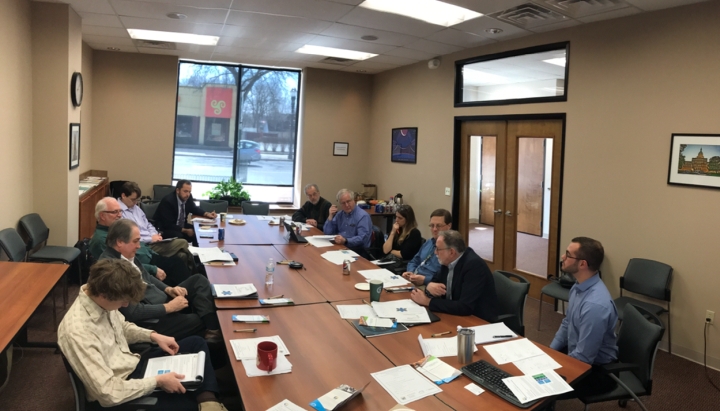Mid-Michigan Particle Accelerator Cluster Study (MMPAC)
By: Nicholas Joblonski and Joshua Weidenaar
 CCED partnered with Lansing Economic Area Partnership (LEAP), funded by the U.S. Department of Commerce Economic Development Administration (EDA), to research and develop strategies that enhance the particle acceleration industry cluster and talent streams for future economic development efforts in mid-Michigan.
CCED partnered with Lansing Economic Area Partnership (LEAP), funded by the U.S. Department of Commerce Economic Development Administration (EDA), to research and develop strategies that enhance the particle acceleration industry cluster and talent streams for future economic development efforts in mid-Michigan.
Since being introduced at MSU in 1963, the National Superconducting Cyclotron Laboratory (NSCL) has advanced MSU’s place as a leader in physics research; the MSU nuclear physics graduate program has been ranked No. 1 nationally since 2010. In 2008, the US Department of Energy’s Office of Science selected MSU for a $730M investment to build an expanded Facility for Rare Isotope Beams at the site of the NSCL. This scientific user facility will enable scientists to make discoveries about the properties of rare isotopes (that is, short-lived nuclei not normally found on Earth), nuclear astrophysics, fundamental interactions, and applications for society, including in medicine, homeland security, and industry.
The MMPAC study provides an in-depth analysis and develops strategic guidance to local private sector leaders, economic development professionals, community planners, educators, and other key stakeholders in the region on actions that are likely to enhance the region’s job creation, retention, and opportunities for economic development related to advanced nuclear physics.
The MMPAC study has narrowed its focus into four key areas:
1. Knowledge and talent supply chain
CCED hopes to further understand what makes a successful regional talent supply chain as well as a knowledge supply chain. The basis of these concepts rests on how we can adapt the changing landscape of the 21st century economy into that of a “knowledge economy.” CCED has identified that creating a pipeline for talent and knowledge into our region and minimizing leakage will support the development of a regional cluster. Regional cluster development allows for the regionalization of a specific industry with benefits coming from agglomeration economies, leading to increased welfare in the surrounding region.
2. National innovative practices
Through the Identification of influential national laboratories throughout the United States, we have identified organizations within national laboratory regions running programs aimed at building regional capacity through the work of the national laboratories. These might include technology transfer programs to help adapt research into practicable business opportunities or facilitating the development of minority owned accelerator business ventures. Through these programs, a pattern of best practice is identified. These recommendations will help community organizations throughout the region begin thinking about how they can capitalize on the opportunities stemming from the Facility for Rare Isotope Beams.
3. Accelerator component and downstream business analysis
With guidance from an Advisory Board, CCED will create a list of accelerator related companies ideally suited for the region. This expansive list of companies will assist LEAP in their accelerator company retention efforts, resulting in more companies remaining in the region. It will also assist LEAP in business attraction efforts, which should result in more companies relocating to the region. The CCED will also map the region’s particle accelerator industry and opportunities in the supply chain.
4. Regional assessment
MSU CCED will identify assets that may create the ideal environment and competitive advantage to grow and develop the accelerator industry in the region. Historically, the region has been tied to the automotive industry, manufacturing, and production. In terms of talent, skills, and experience, these core competencies remain significant; thus the region is perfectly suited for the particle acceleration industry. Through a collection of data and metrics about the region, CCED will be able to identify regional strengths and weaknesses and what organizations might be able to involve themselves in development efforts.
As we continue our research and prepare for the summer, we look forward to being able to identify how to make the most out of the opportunities that come with having a top tier research facility in Lansing’s backyard.


